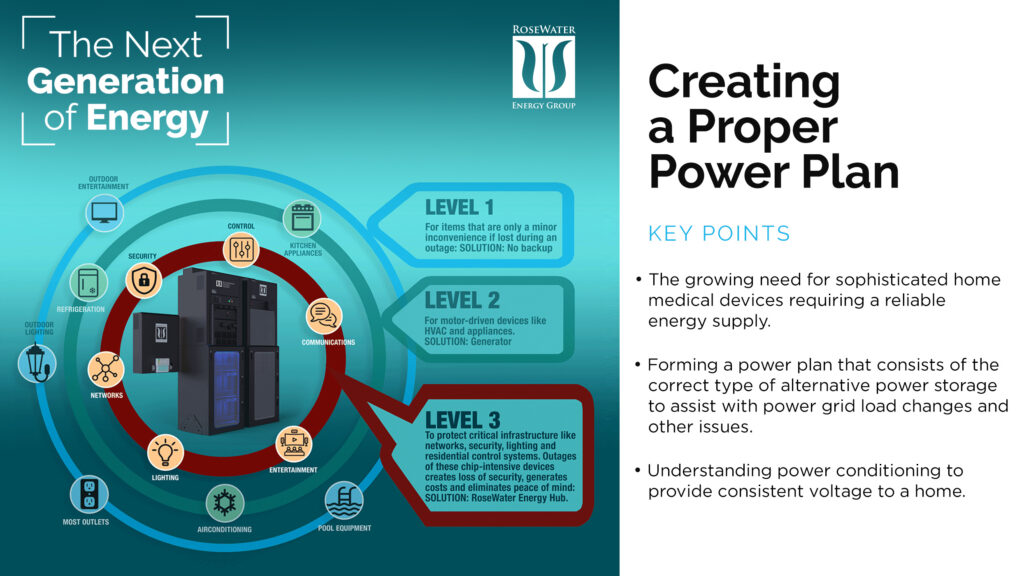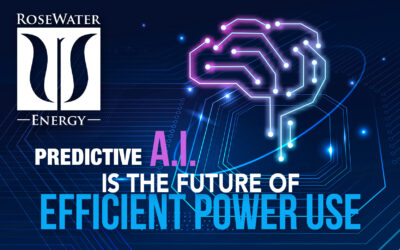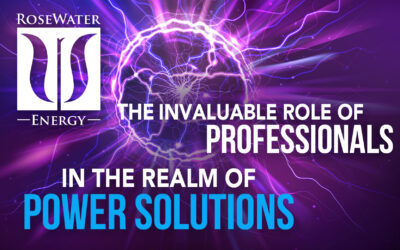
When people think of microprocessors, computers are the first thing that comes to mind. Yet, all the PCs, Apple desktops, engineering workstations, and supercomputers comprise less than 1% of the microprocessors sold yearly. So, where are all these microprocessors hiding? Well, they are in all the devices people use every day.
Today’s homes contain hundreds of microprocessors. Microprocessors make living a lot easier, from wiring to home entertainment systems, lighting, and other smart home devices. What makes all these devices run? Power. And to ensure those devices used to keep a home operating, it isn’t enough to have a reliable power supply; a proper power plan is critical.
Power quality and reliability are two parts of a power plan residential homeowners must understand to keep those microprocessors running efficiently. So, how do people create a proper power plan?
On this epsiode of The Next Generation of Energy, Bobby Brill spoke with the man himself, Joe Piccirilli, CEO of RoseWater Energy, to get those answers and find out what comprises a sound power plan.
Brill and Piccirilli cover the following in their discussion:
- The growing need for sophisticated home medical devices requiring a reliable energy supply
- Forming a power plan that consists of the correct type of alternative power storage to assist with power grid load changes and other issues
- Understanding power conditioning to provide consistent voltage to a home
“The output of a RoseWater power conditioner is always 120 volts,” Piccirilli said. “There is no transfer time involved. Its very function is to make sure that the residents of this critical load panel are always being fed 120 volts. That’s what the primary purpose of this device does.”
Transcription
The Next Generation of Energy podcast: Creating a Proper Power Plan
Bobby Brill: Hello everyone and welcome to another episode. I’m your host for today, Bobby Brill. And joining us as always is Joe Piccirilli, who is going to really break down the idea of creating a power plan. And sounds like a very simple idea and Joe, you can tell us how simple and how unique and developed it needs to be. But Joe really walk us through this idea of creating a power plan. This sounds like a simple idea.
Joe Piccirilli: I would be happy to do that, Bobby. And thank you for the introduction. You know, a power plant is kind of an interesting thing because. Particularly in the residential world, people don’t think about a power plan. They think about a mechanical plan or a plumbing plan or a structural plan for their residence. Rarely do they develop a power plan. And in fact, when I mentioned it to civilians, that vast majority of people out there, their eyes glaze over and they go, “power plan? What’s a power plan?” And I have a box and circuit breakers. What more do I need? Like hit the switch, power goes on, hit the switch, power goes off. Isn’t that a plan enough? And it’s kind of gets, and you know what? 25 years ago, 30 years ago, that really was enough. But if you start to think back and I’m going to take you into the commercial world and the sort of mission critical world of data centers that, you know, suddenly, all this digital data is being stored and there are microprocessors to extract it.
And then of course there’s the military, love them or hate them. They use a lot of digital stuff to do a lot of stuff that we won’t talk about. And they won’t tell us about it, but they’re microprocessor intensive. And as it turns out, when you have lots of chips and microprocessors, power variants of fluctuation and voltage, a spike as we all, all look that electricity spiked and worse, a sag where the electricity drops. Those of you in California know those as brownouts. You know, those are very, very detrimental to the long-term health of microprocessors in the best case, and in the worst case they need to be rebooted or they fry.
Bobby Brill: So, I got a question about that. Cause you say microprocessors and I think for a good number of people listening to this may or may not be thinking of this, that we have so many microprocessors in our house. I mean, we’re, if we’re talking modern times, you’re getting homes that are prewired for internet in every room. You have your smart TV, your smartphone, your cameras, your motion control devices, your HVAC control. I’m sure there’s a dozen others that I’m missing or thousands more that we must have hundreds of microprocessors in our home without even thinking about it.
Joe Piccirilli: Correct. And getting worse every day. Cause you’ve left off all home entertainment, audio video systems, and all your security systems are now microprocessors. And what is coming in the future is getting even more intensive, I mean, think about what is going on. There is a new trend in lighting, for instance. In lighting you can control the color temperature of a bulb. And if you do that because it can enhance artwork, it can change your mood. Well, that requires a microprocessor at every bulb. So, I’ve been on projects where, you know, look, this house has 400 of these.
Bobby Brill: and that’s not a lot when you think about it.
Joe Piccirilli: Oh no, that’s sort of a moderate home. I’ve been in houses where there are thousands.
Bobby Brill: Sure. Sure.
Joe Piccirilli: Yeah. And that’s a microprocessor at every bulb.
Bobby Brill: Oh my gosh. So, we do have in a normal home, a thousand plus microprocessors without thinking about it.
Joe Piccirilli: And if you start thinking about the future, I was talking to a contact, one of the world’s largest contract manufacturers, about what they see as a future product. And we’ve heard this ad nauseum from our political class, how do we bend healthcare costs, the healthcare costs curve. And one of the ways to do that is to have the ability to do home diagnostics. And I mean, complex home diagnostics, including blood tests.
And so home diagnostic devices, which will all be internet connected, will become commonplace within the next decade or so. Because that eliminates a doctor visit and a lab visit, which both cost. So, to be able to have equipment that is accurate, right. Calibrated and remains that way requires stable power. Sure.
Bobby Brill: And the joke of the science fiction of your refrigerator, knowing that you ran out of milk and eggs is nothing compared to a diabetes and blood testing machine, which is far more important to be upkept and moderated and lifesaving.
Joe Piccirilli: Exactly. I mean, now all of a sudden, you’re, it really does become, I hate to use this phrase, but I’ll use it, becomes much more life and death.
Bobby Brill: Right. Well, I mean, that’s, we are getting to that point where, you know, work from home. I mean, all the buzzwords we know, work from home, telecommuting, these are the things, I mean, we’re talking on a podcast. If I opened a door, you’d see, I’m actually in my garage in a closet I built because we’re all working around the world in homes with everything. So that brings us obviously to the point of battery backup, the thing that you are the expert on, how does. And I know battery backup is probably the wrong term, uh, but. Power plan using an alternative power source other than plugging into the grid. And please correct me if I’m wrong. How do we start thinking about that?
Joe Piccirilli: First, let’s kind of define the problem because you have the grid and the grid is just, you know, gigantic generators, right? Spinning and a generator spinning. It’s a coil inside of a magnet and that creates electricity and utilities create something called a base load. And that base load is what they try and run 24/7. But what that base load does or what that generator cannot do is anticipate load or changes in load.
So let us assume here we are in where I live, South Florida, and it becomes an incredibly hot day, hotter than anybody anticipated, or in your, the city of New York or the city in LA and everybody’s air conditioner kicks on. That creates an increased immediate demand for power that the utility was not ready for. So, you get a sag. Then the generator catches up in the case of a utility that a “peaker” plant kicks in. But in that period between the generator not being able to provide, and then the utility being able to provide, there is a drop in voltage and that drop in voltage is incredibly detrimental to every microprocessor you have in your house.
And then I’m going to just keep going for a moment. All those things turn off. Well, the generator didn’t know now you have a spike and then it settles down. So, as we continue to consume more and more power, and we don’t build power plants, this gets worse and worse and worse.
Bobby Brill: And you’re not saying anything that sounds otherworldly. Every single person has experienced this in multitude, at least in the last two years, if not longer. I mean, this is a common thing. I mean, the average person, every time there’s a rainstorm, there’s a rainstorm in California where I’m at or a hurricane in Florida where you’re at. Immediately Costco, Walmart, and every big box retailer magically pulls out pallet loads of generators as a stop gap for nothing, but people run to buy them.
Joe Piccirilli: Exactly. And your little home generator, right? Which really can’t anticipate load, really sags and surges. So that is even more detrimental to the things in your house. So, it is a problem that is a very difficult problem, a difficult problem to do anything about other than have devices in your home that condition power and what does conditioning power mean? And what it really means is, for instance, with a RoseWater device, regardless of input, so 60 volts, zero volts, 150 volts, the output of a Rosewater is always 120 volts, always. There is no transfer time involved. It’s very function is to make sure that the residents or the panel, this critical load panel, is always being fed 120 volts. Now we can go into how it does that, but that’ll be the subject has been the subject of past podcasts, and I’m sure will be the subject of many other podcasts in the future, but that’s what the primary purpose of this device does.
Bobby Brill: This is not the band-aid of the generator I buy and stick in my garage and never turn on and pray it works.
Joe Piccirilli: You, you made a great point because in the case of true power conditioning, it is engaged 24 hours a day, seven days a week, whereas a generator or battery backup are only engaged when power’s out. And the purpose of this device is not only to protect you when power’s out, but to protect you when power’s on because the power’s just not that good.
And that’s, that’s really think about you live in the Bay area. I live in South Florida. When I moved to South Florida, 50 years ago, the houses along the intercoastal, except for Palm beach were 1200 square foot winter cottages. Yeah. Today, those are now, well, the small ones are 12,000 square feet and then they get bigger than that. And they’re in the same locations and guess what? We haven’t built a power plant in 50 years in this state. So of course, we have problems.
Bobby Brill: Right. And again, this is not isolated between Florida and California. Nothing you open up, you, you, you, God forbid you rip off the drywall and you go, what is this knob and tube? I took a picture of my electrician’s eyes just exploded in joy for the amount of money he’s going to extract from me.
Joe Piccirilli: So, you know, it is, between the exploding demand for power, the infrastructure that is so old, you know, it’s, it’s, it’s great that the thing works, it’s great, but you know, in this day and age, we really have to have a plan for how do we protect those items that are critical to our lives and our lifestyle, and that’s what a power plan is about.
And if you were to look at a power plan, a power plan should look essentially like consecutive rings of protection. And this is the way everybody does it in the commercial world. There is an outer ring, and the outer ring may be devices that are not important to you, maybe your pool equipment, your outdoor lighting, you know, things that in a power outage, you don’t try, you don’t hook them up to your generator.
Bobby Brill: You could live without for weeks at a time.
Joe Piccirilli: You could definitely, cause you don’t want to increase power demand when there isn’t enough power, so, you know, you can, and you leave that outer ring unprotected, just leave it alone. Then there is a second ring inside, you know, closer to the center.
And that second ring is things that consume a lot of power, but are not necessarily microprocessor intensive. For instance, elevator motors, for the HVAC system, for the HVAC, big air conditioning motors, big heat loads, those are not particularly microprocessor intensive. Now their control systems are incredibly microprocessor intensive, but the actual condenser, those things are not microprocessor intensive, therefore are not as sensitive to power fluctuations. So with those, I might choose to protect those with a generator or large scale battery backup.
Then there is the inner ring. In the inner ring, there are things that are incredibly important to you. It’s really nice on that inner ring to have all of your lighting, all of security, all of your networking, you know, cause that’s part of your communication package, right? All of your home control systems in today’s world, particularly in modern homes, you have lighting controls and the lighting controls, you know, are no longer on off switches, they’re buttons that can create scenes or that turn on your lights or dim your lights. Those things don’t have manual overrides. So, if your lighting control system goes, you can’t turn on your lights, that could be problematic. That could ruin your day or your night in particular.
So, you know, you want those kinds of things protected by power conditioning. And unfortunately for everybody out there, that inner ring is getting larger and larger and larger. I have clients, lots of clients from RoseWater who want their wine rooms on that because they have really expensive wine collections.
Bobby Brill: Sure. I mean, somebody hearing this may laugh at that, but when you talk about insuring a wine collection, you’re talking six, seven figures. This is, this is reality. This is a lot of money. That’s a lot of money, literally spoil overnight.
Joe Piccirilli: There are people who look, my refrigerator is micro, you know, I have one of those refrigerators that take inventory. However, if that microprocessor goes, the refrigerator stops working. So it’s not that I care about the inventory as much as I care about the fact that the thing’s working, you know, because a couple of days without my refrigerator, everything that’s in it is spoiled. It’s funny.
This is just a somewhat of a side, but Wolf, the people who make ranges and ovens, Wolf now includes in their owner’s manuals a section on how to reboot the microprocessor in their devices. So imagine cooktops have microprocessors built in.
Bobby Brill: I have actually, you joke, but I’ve had that. I have a refrigerator from a, from a large retailer where at one point it was like, you need to turn it on to the other side, but I’ve had that. It’s like, you need to turn it on, turn it back off and we’ll reset it for him. Like my refrigerator, this is a bad sitcom joke. It’s like, no, but this is, but as you, as we’re laughing about this, you know, you are pointing out those things that we all don’t realize or are not really paying attention to that. Yeah. If the food spoils, if the wine room goes down, if all of the things we need that we are now living on fail because we have not planned for power, our lives are really annoyed.
Joe Piccirilli: I mean, it is amazing as we have become more and more dependent on microprocessors and that kind of, um, convenience, because microprocessors are create incredible amounts of convenience for us, but like everything else, they have their own vulnerabilities and the point of making a power plan is how do you appropriately ensure that the type of power being delivered to your house, because you’re not going to change the utility, that’s not going to happen. How do you ensure against what are the typical weaknesses of utility?
And you, you have to keep in mind that, you know, again, there is a move towards putting renewables or, or generating electricity on large scales through renewables, renewables are intermittent in nature, the wind doesn’t blow all the time, nor does it blow at the same speed all the time. Solar energy is really great when the sun shining, a cloud goes by, you could lose 90%, the demand is still there. All of a sudden, the supply is choked by 90%. That’s problematic. If we go forward with the push towards electric vehicles, that power has got to come from somewhere.
Bobby Brill: Right. And that’s, and those are heavy demands. Heavy. I think it’s, I think, what is it? It’s a 50 amp breaker just alone for one charging unit for the average home is 200.
Joe Piccirilli: That’s only for the second level charger. They do have third and fourth level chargers, but God forbid you plug one of those babies in.
Bobby Brill: Well, you know, and again, we were laughing at some of these things that seems so obvious that it’s, you know, people are forgetting that, you know, I’ll point it out as somebody who owns an electric car and lives in a house. It’s only got a 200, uh, you know, 200 rate, uh, 200 amps, 200 Watts, 200 amps, 200 amp breaker, uh, the charger needs 50. And, you know, everyone, as the electrician is telling you, just by the way, don’t charge your car, run your dishwasher, do laundry at the same time. And you’re like, I’m sorry, what are you serious? He’s like, yeah, don’t do that. I’m like, I have to remember that. He goes, oh yeah, don’t do that. Don’t do that when, so that really goes into this conditioning concept you were talking about. How do people think about this?
Joe Piccirilli: Again, the phrase, how do people think about it? And that is what is problematic. And in the general public is up until recently, nobody has thought about it. And, and the level of knowledge out there is very, very limited.
That again, you’re probably too young for this,
Bobby Brill: but I’ll take it.
Joe Piccirilli: When I, when I first started in the consumer electronics business, well, more than 50 years ago now, um, we sold VCRs and VCRs were the first indication of power quality problems because of how often we had to re tell, teach people how to reset the damn timers on the VCR, which nobody, oh my God, that’s so complicated, how am I going to do that? I have to push how many buttons? You know, they, they went out constantly and that wasn’t because the device went out is because the power went out.
Bobby Brill: Right. So the infamous bleaking 12 o’clock for just put a piece of tape over it. Don’t worry about it. No problem.
Joe Piccirilli: But you know, that was the consequence back then, or you had to reset your digital clock. Well, now the consequences are much more severe. So that is why, you know, we have to, we have to make sure that we don’t have to do it again. And that’s why, you know, we at Rosewater really promote the concept of a power plan. And, and by creating this power plan and going through this exercise, which, I mean, it could take a half an hour. It’s not that huge a thing, but it allows you to appropriately allocate budget to something that is critical and not considered as a power plan, you know, and, and unfortunately it is not like. The trusses where you need a structural engineer, because rarely are you involved in, yeah, this is how my truss is to be in the house, or you’re not going to lay out the plumbing.
However, you can lay out and say, wait, these are the things I do not want to compromise. These are the lifestyle choices. You know, and go back to the truss example, you believe that the structural engineer is going to build a truss that is not going to allow your roof to fall on your head, but in this world, you have to advocate for yourself when it comes to a power plan.
Bobby Brill: You used a couple of terms that I think are fascinating. You said advocate for yourself, which I don’t think anyone’s even contemplated that when they are thinking about their power and lifestyle choices. And I’m sure you can talk deeper about those, but explain to me the, the advocate part, because that’s a really interesting way of thinking about this.
Joe Piccirilli: Well, again, you know, we, we hear that term out there, you know, typically now in the world of medicine, you go to a hospital, they tell you, you have to advocate for yourself because you know, it’s very difficult. And it really, it is the same sort of analogy. This is how I would like to live my life. And you cannot expect the person building your house or the person doing the electrical work in your house to know your lifestyle. And this is your chance to sit down and say, wait, these are the things I want, I will be uncompromising about.
And I, think that if somebody doesn’t engage you in this conversation, you need to speak to someone else. Because one of the things I, our dealers, people who sell Rosewater, that’s what they do, they come to the client and they go, okay, we’re going to talk about a power plan for your house. And granted, most of the clients go, what’s a power plan? And then we go through the similar dialogue where, okay, these are the rings of protection you need. This is why you want this protection.
Often, I hear people, oh, we have perfect power. Really? So, you’ve never engaged in a brownout. Does your stuff in your house ever need resetting? Well, yeah, those are power problems, you know, because people don’t equate the two. That’s the biggest problem here, is people don’t make that connection, no pun intended. And so they have no idea what the source of the problem is. They actually think it’s the fault of the equipment. And it’s not.
So, my message here is really, I am an, I’m an advocate, obviously, of RoseWater, because it’s my company, but, and I believe in what, you know, I founded it for this very reason. But to protect your lifestyle and protect the place you live, the place you spend the most time, and the place that is supposed to give you the most pleasure. And that’s what this is about.
If you’re not going to think about a power plan, you are doing yourself a disservice. And if I could leave everybody with that simple message is, hey, think about a power plan for whatever you’re doing. If you’re doing a remodel, if you’re building a new house, think about a power plant.
And if you have any questions, obviously, you know, you can contact us. It’s info@rosewaterenergy.com and we’d be happy to help you out. So that’s my message for today.
Bobby Brill: Joe, you have enlightened us all to think about not only our own comfort, our future and what that means for us going forward in life. But also, you know, again, this has been a fascinating conversation. Really, really excellent conversation, Joe. Thank you.
That has been Joe Piccirilli, the founder of Rosewater Energy, who is going to really want you to plan your power and think about what you’re going to do with your life.
Joe, again, thank you so much for joining us.
Joe Piccirilli: Thank you Bobby.



